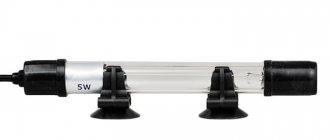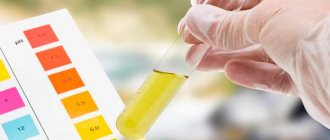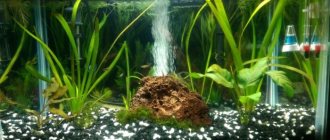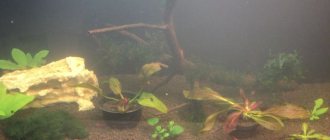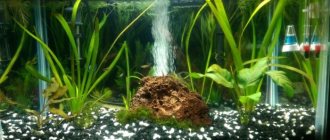We want to draw attention to the cleaning technology that has become popular recently. Let's take a closer look at what water aeration is and why it is needed, the advantages it has, what types it comes in, what type it should be used in production and at home.
Separately, we note that the methods that are relevant today are more than widespread - they are used everywhere and in a variety of areas, from domestic needs to fish farms. In addition, their entire set is highly promising: new solutions are emerging in this area, more convenient, faster, and more advanced. Efficient and economical installations are being developed for special cases, and you will find a wide variety of them in our catalog. But let's get to the point.
What is aeration
This is the process of saturating water with oxygen (less often with ordinary air) for the purpose of purifying it. Such enrichment triggers natural chemical reactions, as a result of which dissolved impurities become oxides and precipitate, and this can then be relatively easily retained by trap filters and removed. After that, volatile compounds, toxic and unpleasantly smelling, are removed.
Using variations of the method, it is possible to effectively remove particles of metals (for example, iron or manganese), gases (hydrogen sulfide, chlorine, methane and others), carbon dioxide and organic compounds, as well as bacteria and viruses, from liquids.
Vortex compressor for pond
To maintain the pond ecosystem, there must be a sufficient concentration of oxygen in the water. If due to some factors it becomes small, this can lead to the death of fish and other organisms.
In such cases, forced saturation of the reservoir with oxygen is necessary. For this purpose, a vortex compressor is best suited, which is the basis for a pond aeration system, which can be purchased in our catalog.
Fundamentally, the process of aerating a pond is not much different from aerating an aquarium with fish. Air is supplied into the water column of the aquarium by a membrane microcompressor through a tube ending in a porous aerator. Air bubbles rise to the surface, saturating the water with oxygen.
In reservoirs, the same thing happens, only superchargers with much higher performance are used.
Rice. 4. Pond aeration
Why is aeration needed?
With water purification you can:
- remove harmful salts from it;
- carry out its biological treatment;
- increase oxygen concentration;
- remove unpleasant and any foreign odors.
Please note that liquid with excessive iron content is unsuitable for drinking or cooking, because if consumed regularly, this excess will be deposited in the body and will gradually lead not just to poor health, but to chronic diseases, seriously compromising health. It is also not suitable for household purposes, since its salts will spoil the laundry during washing and generally settle on the internal surfaces of heating elements, pipes, and plumbing fixtures, gradually clogging all passages.
How to make a compressor yourself
You don’t have to spend money on a compressor, because you can make one yourself. To do this, you need to purchase some elements (motor and power supply). Then it's a matter of technique.
What do you need for work?
To make a compressor for an aquarium, you need to prepare the following tools and materials:
- electric motor;
- a piece of wire;
- a sheet of plywood and several blocks of wood;
- awl;
- hot glue;
- a thin wooden stick (suitable for a lollipop);
- rubber tube with adapter;
- scotch;
- candles;
- plastic cover;
- camera from a ball or bicycle;
- power unit.
First, prepare everything you need.
You also need one balloon for the compressor. Once everything you need is at hand, you can get to work.
Instructions
Below are step-by-step instructions, following which will greatly facilitate the process of manufacturing an aeration compressor.
Step 1. Cut the balloon in half using scissors.
The ball is cut in half
Step 2. Drill two small holes in the plastic cover, 3 and 6 m in diameter. Any rough edges must be sanded to obtain a smooth surface.
Holes are drilled
Step 3. Cut out a horseshoe shape from rubber. Then carefully glue the resulting horseshoe using a glue gun to the drilled lid (to its inner part).
Cut out this part
Step 4: Pull half of the balloon onto the lid. Make sure that the surface of the structure is elastic. Secure the ball with tape and carefully cut off any excess.
Pull half a balloon onto the lid
Step 5. Cut a small triangle from a sheet of plywood. Its dimensions must correspond to the dimensions of the motor. Glue this motor to the plywood. Now make the base for the compressor by making legs from blocks. You should get a small table on which the motor and power supply are located.
Motor based
Step 6. Make an eccentric by shortening the hot glue stick, cutting off 6-8 mm. Then make a hole on the side and top using a regular awl. Pass the wire through the side hole. Install the finished eccentric on the motor shaft.
A hole is made with an awl
Step 7. Shorten the wooden lollipop stick to 4cm and glue it to the candle holder. Then this structure must be attached to the eccentric. The other end of the stick must be glued to a plastic lid with a ball in the center. The lid itself must be attached to the plywood using the same glue.
Stick attachment
Step 8. Make a small hole for the lid with the ball and fix the adapter in it. A rubber tube must be attached to this adapter. That's all. aeration compressor is ready to use!
Homemade compressor for aeration
Water purification by aeration
Its advantage is that you can find your own approach in absolutely any case, focusing both on the final goal and on the current conditions: the volume of the working environment to be enriched, the current flow pressure and other important factors.
Naturally, the equipment used, productivity, and cost level directly depend on the chosen method. Therefore, you need to immediately decide why you are solving this issue, why you need the liquid - to service a cottage, a country house with several floors, a personal plot with greenhouses or an industrial facility.
Today there are 3 main methods - let's look at each of them in order.
Biological aeration
It is based on a natural phenomenon, which is that the oxygen level in water depends on the amount of phytoplankton in it, which directly produces 80-90% of all air in the working environment.
Hence the simple dependence: the more of these organisms, the sooner the enrichment will occur, which means their growth must be stimulated in every possible way. Why it is permissible to use a variety of approaches:
- add mineral fertilizers that activate natural metabolic processes;
- populate a body of water (aquarium, container) with fish that eat vegetation; for example, grass carp or silver carp, since they eat adult individuals, forcing the young to reproduce and at the same time generate oxygen.
The second option is also good because it has a complex effect. First of all, because not only phytoplankton is absorbed, but also detritus, which would certainly take some part of the air if it remained in the water. In this way, oxygen is not only produced, but also saved. In addition, the vegetation that prevented organisms useful to us from reproducing is also destroyed along the way, and it is eaten and does not die, and gas is also not spent on the processes of its decomposition. This is the case when indirect influence plays an extremely important role.
MBFT-75 Membrane for 75GPD
SF-mix Clack up to 0.8 m3/h
SF-mix Runxin up to 0.8 m3/h
Chemical aeration
This is an artificial method with a very simple principle: add reagents to the working environment that increase the activity of oxygen release. There are a lot of suitable substances, and examples include:
- hydrogen peroxide – H2O2;
- potassium permanganate – KMnO4;
- calcium peroxide – Ca2O;
- a number of others, less commonly used.
Here it is necessary to take into account that each such catalyst not only has its own degree of effectiveness, but also certain side effects. Thus, as a result of interaction with Ca2O, slaked lime is also formed, which accelerates the much-needed enrichment reaction.
To solve the issue chemically, you should add the calculated amount of the substance to the liquid. So, to release 1 liter of oxygen, you should add 4.6 kg of calcium peroxide.
The nuance is that the proportions must be strictly maintained: if the concentration is not maintained, the air simply will not be released in the required volume, but if it is exceeded, serious damage can be caused to both the local water supply system and the environment in general. Therefore, it is important to remember that each catalyst has its own proportions and adhere to them.
Mechanical aeration
The most used option is because it is carried out practically in a passive mode, almost without human intervention, and proceeds relatively quickly. In addition, it does not pose even a theoretical threat to the environment, and this is a key advantage on an industrial scale.
It is implemented quite simply - as follows:
- a table is installed in the container;
- it is supplied with a working medium from a pipe;
- falling, the liquid breaks, part of its drops flies to the surface, receives an air charge and returns to the reservoir.
Now we have presented the simplest saturation scheme, on the basis of which other, more complex solutions are improved and implemented. Examples include the well-known sprinkler systems, which are widely used to irrigate farmland and thus help grow various crops. In fish farms, special devices are also in demand, but only in cases where the inhabitants of rivers, lakes and ponds are more than 2.5 t/ha (according to calculated data).
Wind turbine aerator
Now we invite you to consider a technical solution that is more labor-intensive in terms of implementation, but less expensive (in terms of financial investments). It is based on the use of wind energy. Directing it to aerate the reservoir is quite simple. An ordinary windmill and a simple frame that will reliably support the structure in windy weather are the main elements of an aerator that can work wonders.
The basis of an aeration installation powered by wind energy can be a homemade Savonius rotor. This is the simplest windmill to manufacture, capable of performing useful work even with small gusts of wind. Let's look at the design of such an aerator using an example suggested by one of our users.
The operating principle of such an installation is simple: the windmill rotates a vertical shaft on which (under water) a water mover is located. A propeller with several blades can be used as a propulsion device.
Aleksej2000
A 200 liter plastic barrel was used for the blades. The water mover must be made in the form of a propeller. This will enhance the mixing of the water and make its movement uniform. I use the blades of a car fan (which is used to cool the radiator) as a “propeller”. Having installed the structure, we were amazed by its energy: the water was literally bubbling. Arriving a day later, we saw that instead of a hole with a diameter of 40 cm, a hole 3 meters in size had formed under the windmill. The ice at the time the wind turbine was installed was 42 cm thick. It washed everything away.
To prevent the propeller from being blocked by ice in calm weather, it must be located at a sufficient depth (below freezing water). In addition, a special unit, which the author of the design called an “anti-freeze agent,” helps maintain the functionality of the device in severe frosts.
The antifreeze device is a pipe with two bearings, bushings and seals (seals), through which the operating shaft of the installation passes.
The upper part of the device will always be above the water, the lower part will always be under water (below the freezing level). This is what the anti-freeze guard looks like assembled.
Even if the outer pipe freezes into ice in calm weather, the aerator shaft will still continue to rotate at the first gusts of wind. In other words, the installation will be able to operate completely autonomously.
Aleksej2000
What is an antifreeze agent? This is an axle, two bearings, a pipe, bushings and seals. To a turner for an hour of work (maximum). Calm weather is not scary as long as the antifreeze allows.
To give the water flow a lateral direction, the design of one of the aerators (the author has several of them) was improved. Replacing a car fan with a small radial fan, a volute removed from the ventilation system, significantly increased the efficiency of the aeration unit.
As you can see, it is quite possible to build an effective aerator without resorting to large financial costs. The next chapter is for those who want to invest in creating an aerator to the maximum.
How is aerated water produced?
In general, the process of enriching it with oxygen takes place in 3 stages - according to the following scheme:
1. The production of oxygen is stimulated (by the chosen method - chemical, biological or mechanical), triggering reactions as a result of which dissolved impurities are oxidized to a di- and trivalent state.
2. Foreign substances precipitate and are captured by filters (so that they do not accumulate on the bottom and walls of the container).
3. The gases remaining and released as a result of the interaction (ammonia, hydrogen sulfide, chlorine) are blown off.
Benefits of aerating water
There are other ways to remove iron from water. However, aeration is considered the best of them. This is due to the many advantages of this cleaning method.
Benefits of water aeration:
- Such a device is absolutely safe; it does not require the addition of any reagents. Therefore, the water cannot contain any chemicals.
- Aeration does not require replenishment of reagents. Therefore, the use of aerators is cheaper than the operation of other devices that give a similar result.
- Such systems make it possible to remove iron from large quantities of water in the shortest possible time.
- In addition to the fact that during aeration, harmful substances are removed from the water, the liquid becomes healthier. After all, it is enriched with oxygen.
- The operation of the aerators is fully automated, so human intervention is not required.
- During such cleaning, no by-product chemicals are formed. Aerators are absolutely environmentally friendly.
Aerators are an excellent option for purifying water from iron and some other compounds. Therefore, they are preferred to many other devices.
Drink clean water and be healthy!
Types of water aeration
In addition to ways to increase air concentration, there is a division according to a number of parameters. This includes the level of complexity of the equipment used and the nature of the reagents used. But there is one factor that stands out. This is a method of supplying oxygen, and, in accordance with it, there are two schemes - let’s move on to consider the first.
SF-mix manual up to 0.8 m3/h
AMETHYST - 02 M up to 2 cubic meters/day.
Aeration unit AS-1054 VO-90
Gravity
The short gist is this:
- The liquid enters the tank through nozzles (special nozzles), that is, with dispersion.
- As they fall, the droplets mix with the air contained in the atmosphere.
- At the same time, the membrane compressor also pumps oxygen at the bottom.
- Interacting, the molecules are oxidized, and the dissolved forms contained in the water precipitate and are removed by filters.
- The working medium is pumped out using a pump and supplied to the end points of consumption.
Installations operating on this principle are used when the liquid contains excess salts, hydrogen sulfide and methane, as well as in cases of excessive color and turbidity or the presence of an unpleasant aroma.
Non-pressure systems built on the basis of the method differ in size and performance, and while some of them are aimed at cottages and country houses, others will satisfy the needs of even large industrial enterprises. They are quite environmentally friendly and safe, so it is permissible to supplement their capabilities with reagent cleaning - in the presence of a serious excess of organic compounds and/or low pH levels.
Let's move on to the second scheme.
Nadornaya
The most widespread technology - due to its economic profitability, speed of implementation and complete absence of harm to the environment. This is implemented in the following way:
1. Water is taken from the source and then supplied to the inlet of the purification column through a flow sensor.
2. Having received the appropriate signal, the flow switch starts the compressor, which begins to pump air into the container through the tube.
3. The liquid is mixed with gas and thus saturated with oxygen and poured into a reservoir under significant pressure.
4. This mixture is allowed to settle for 30 minutes (or longer) to allow oxidation reactions to occur and sediment to settle, after which it is passed through filters that absorb solid particles and sent to points of consumption.
Or another scheme is possible:
- The working medium is collected in a volumetric container, for example, in a special column.
- At the level of the middle of the tank, oxygen is supplied, which begins to rise.
- Reaching the top, the gas not only naturally starts the aeration process, but also systematically accelerates it.
Application for removal of dissolved gases
Everyone knows that carbon dioxide contributes to the destruction of pipes, and hydrogen sulfide saturates the liquid with the smell of rotten meat. In order for water to acquire high quality indicators, it is necessary to get rid of unwanted gases in its composition. This process is called degassing. This eliminates ammonia and its residue, as well as nitrogen oxide and hydrogen sulfide.
In order to maintain the purity of water in ponds, bottom aerators are used, which significantly improve the physical and chemical parameters of the reservoir Source Sveklon.ru
A chemical method of removing gases is resorted to when it is impossible to process compounds in a gaseous state or when their content in water is low. However, such degassing is characterized by the complexity of the process, the high cost of reagents and the risk of damage to the liquid due to an incorrectly calculated dose of the substance. These reasons have led to low demand for the procedure.
Aeration is considered a physical method of degassing. It aims to minimize the partial pressure of gas upon contact with liquid.
Types of degassers
The following types of degassers are distinguished:
- film They have a columnar structure with nozzles. Water flowing through the nozzles comes into contact with air over a large area. The material used to make devices in the form of rings is ceramic, wood or plastic;
- vacuum The principle of operation is to use a vacuum pump to bring water to boiling water without changing the air temperature;
- bubbling Air under pressure greater than atmospheric pressure is passed through the liquid;
- thermal. As the water temperature rises, the unwanted gas evaporates.
Before aeration, it is recommended to settle the water from the well, for which the simplest tanks with a float system are made Source Remont-book.com
Film devices are considered cost-effective, are small in size and highly reliable. The operation of such degassers is based on the supply of air through a fan to slowly flowing water. After contact with gas bubbles, the liquid ends up in a special container, from where it is removed through a water seal.
Degassers using compressed air consume a large amount of energy and, as a result, are rarely used.
What are aeration water purification systems?
Each of them is a set of equipment that differs from analogues and competitors in the degree of complexity, performance, reliability, but necessarily has the following advantages:
- autonomous functioning (or with minimal human intervention;
- ease of maintenance - low maintenance and low investment of time and money to maintain all modules and components in working order;
- compact dimensions - for trouble-free installation not only in production, but also in a personal plot or even in a house;
- economic efficiency.
Advantages and disadvantages of the method
Aeration as a method of purifying water in aquariums, ponds or taken from a well/well has the following advantages:
- Oxygen safety. The gas used to process the environment is non-toxic, free, and has a rapid oxidizing effect. Oxygen does not form compounds hazardous to humans.
- When using pressure aeration, it is possible to significantly reduce the dimensions of installations. In turn, this allows you to save space on the site/in the house, which cannot be said when using non-pressure installations.
- There is no need to use additional expensive reagents for high-quality water treatment.
- Full automation of the process. This frees the technician from labor costs and the need to monitor the operation of treatment systems.
- A clear diagram of equipment installation and the principle of its maintenance.
Installation of a pressure or non-pressure system can be carried out even by a master without experience.
Aeration of water from a well
Yes, it may also contain impurities, and if they were not there yesterday, according to experts, this does not mean that harmful substances will not appear in it tomorrow, after the composition of the soil changes. So it’s better to play it safe and filter it, especially if it is used for food, and for other household purposes too, because otherwise the sewerage pipes or watering seedlings in the greenhouse will sooner or later become clogged due to sediments.
Properly selected equipment will allow you to quickly remove excess manganese and other metals, hydrogen sulfide. It is important to use a filter that can capture even relatively small particles of sediment and will not clog for a long time.
Main table dispenser AquaPro 919H/RO (hot and cold water)
Main table dispenser AquaPro 929CH/RO (cooling/heating)
Floor dispenser AquaPro 311 (empty, without cooling)
Maintenance
Maintenance of the aeration column should be carried out every 6 months. In practice, cleaning the aeration column is carried out when the following problems appear:
- drop in water pressure;
- the appearance of iron in water;
- water leaking from the head.
As a rule, when such problems occur, maintenance of the entire water treatment system is usually carried out.
Maintenance schedules may vary depending on the aerator manufacturer. Usually the deadlines are specified in the equipment passport.
Do you want to carry out maintenance yourself? Then you need to buy citric or oxalic acid and make a solution in a small bucket. It is advisable to add hot water to the acid. I won’t tell you how to concentrate, I always do it “by eye”.
You disassemble the aerator, wash the body, the head with everything on it except the tube, put it in acid for 15 minutes, then rinse it in cold water and reassemble the aerator in the reverse order.
Please note that before dipping your hands into acid, be sure to wear rubber gloves.
It's quite simple. And if it doesn’t leak anywhere, it means that the installation and dismantling of the aeration column was completed successfully.
How and where is simplified water aeration used?
It can be used with any of the approaches if the liquid is capable of creating a catalytic film during the process of enrichment with oxygen and precipitation. This will not happen if the concentration of the same iron is below 70% of all impurities. The current oxygen content is also important: it should be at a level of 6 mg/l. And we should not forget about the height of the spout - 0.5 m above the drop level.
There are factors that reduce the effectiveness of the procedure, or reduce the result to zero, and these are:
- low pH level;
- too strong oxidation;
- presence of carbon dioxide or hydrogen sulfide.
The scheme of the method is as simple as possible: the working medium passes through the nozzles, simultaneously being saturated with air, falling into the tank and immediately draining into the main channel. In this case, there is no storage tank, which significantly reduces costs, but also does not allow for the maximum degree of purification.
Types of systems by type of design
To achieve these goals, one of the types of organized natural ventilation design can be used:
- channelless aeration;
- channel aeration.
The main selection criteria are the size of the room, as well as the amount of internal heat generation.
Channelless aeration
For large premises, as well as structures with significant heat generation, a system of specially designed supply and exhaust openings with an adjustable degree of opening is used. The walls are equipped with openings, and aeration lanterns (also equipped with openings) are installed in the roof. Transoms are installed in all openings, which can be opened and closed using a mechanical drive from the floor of the room.
There are several common designs of aeration lanterns. One of the most advanced is the Baturin-Brant system. Its distinctive feature is that the transoms are located as close as possible to the high-pressure zone.
In the warm season, air flow into the room should be at a height below 1.8 m from the floor. In the cold season, on the contrary, the height of the inflow should be more than 4 m from the floor. Such measures are necessary for better air exchange and to prevent exposure of people in the building to cold air. They can only be executed with two rows of transoms.
Channel aeration
This type is suitable for small rooms and rooms in houses with 6 or more floors. Polluted air goes into ventilation shafts located in the walls. Deflectors are installed on the roof of the building in those places where the channels exit. These elements create draft when blown by the wind and due to this, the air in the room is aerated.
The deflector is designed so that when a wind flow hits it, a vacuum is created along its perimeter, which will ensure air exhaust from the ventilation shaft. The most common are TsAGI deflectors, consisting of a cylindrical shell mounted above the exhaust pipe. A diffuser allows you to improve the hood - the pipe smoothly expands at the end. To prevent moisture from entering, a cap is installed on top.
How to set up the process of aerating water from a well with your own hands
You can organize an effective system yourself - for this you need:
- install a pump that draws from the source;
- connect to it saturation equipment located in the basement of the house or other suitable warm place with a stable microclimate and humidity level;
- connect to it a filter with a capacity of 250 l/day (it is better to take it with a reserve, for all household needs);
- then place a settling tank of the appropriate capacity;
- connect it all with pipes that should be led to plumbing, heater and other points of consumption.
Or you can do it easier and buy a ready-made system that has proven its reliability in practice. Specialists from the Water of the Fatherland organization can help you make your choice based on your goals and capabilities.
Connecting the aeration column
Installation (installation) of the aeration column does not require special skills. To introduce an aeration unit into a water purification system, in addition to equipment, you will need:
- Combined collapsible couplings (MKR, American) with external thread - 2 pcs., usually the connecting size to the head is 1/2″.
- Fum tape.
- Tools: gas adjustable wrench (2 pieces are enough for me), hammer drill and screwdriver (attach the stand for the compressor to the wall).
If you can’t find American ones for 1/2″, you can take 3/4″ and an adapter for 1/2″, as well as elastic bands for them. In practice, the rubber bands calmly hold pressure up to 6 atmospheres (I haven’t tried it at higher pressures).
We choose a place, attach the stand for the compressor to the wall, and the compressor itself to it. We assemble the column, carefully wrap the fum tape on the American ones (with a cone - the closer to the base, the thicker).
Next, we assemble the aeration column according to the diagram.
Aeration column connection diagram
Aeration columns can be supplied assembled, then all that remains is to screw on the American ones and connect the compressor and the head with a tube.
Otherwise (if you want to assemble it yourself), to install it you need to follow these steps:
- Insert the water-lifting tube into the head and tighten it until it stops. When doing this, do not miss the rubber gasket.
- The air supply tube with dispersants at the end must be secured to the water-lifting tube using plastic ties or tape.
- Screw the air separating valve with a tube into the head (wrap fum tape around the threaded connections).
- Screw the tap into the head to connect the pressure gauge.
- Screw the head to the cylinder.
- Screw the pressure gauge to the tap.
- Wrap the fum tape around the American ones (water inlet and outlet) and tighten them.
- Insert the air supply pipe from the compressor.
- Solder the pipes.
- If necessary, tighten connections.
The assembly of the aeration column is complete.
Do not overtighten plastic threaded connections with a wrench. It is better to hold them out after water supply than to tear them off.
If you have tightened the connection, but water is still coming out of it, you need to disassemble it and “pack” it again - most likely you have not wound enough fum tape.
The use of aeration for iron removal and removal of organic matter
One of the following schemes is implemented:
- Pressure - the working medium is pumped and passes through the catalyst, which significantly accelerates the oxidation reactions. The amount and strength of air exposure is regulated by the compressor; impurities are precipitated as the flow passes through a filter with sorption granules, which are then washed into the drainage.
- Non-pressure - a constantly high pressure is no longer maintained in the container, as a result of which water passes through the system somewhat slower than in the previous case, because it requires some time to be enriched with oxygen and settle. After which it is pumped into a deferrizer, partially filled with a substance that causes the transformation of dissolved elements into solid ones.
- Reagents + pressure – using a dispenser, sodium hypochlorite is introduced into the liquid, which immediately reacts due to the pressure. Then the working medium is directed into a tank with filter granules, on which impurities are deposited. Residual suspended matter is washed out with a reverse flow, and excess NaOCl is eliminated by sorption materials.
- Reagents without pressure - the scheme is similar to the previous one, the only difference is that water with a catalyst added to it is first settled in a special tank for about 30-60 minutes - to start and carry out oxidation reactions - and only then goes further through the system.
It’s the last two methods that also help remove organic matter.
Criteria for selecting systems
Installations for water aeration must be selected taking into account the final purpose of purification. When you take drinking water from a well, you get a liquid that contains large amounts of iron, manganese, and carbon dioxide. There are more such substances in groundwater than in open water bodies.
If the level of contamination with organic iron compounds exceeds 4-5 mg/l, then the use of reagent oxidizers such as active chlorine and potassium permanganate is added to aeration filtration.
A pressure system is installed when it is necessary to remove iron from water. The liquid passes through a cleaning filter where a catalytic filler-deferrizer is located. Iron particles settle on the outer part of the sorbent granules. The leaching of iron into the drainage is facilitated by the reverse running of water through the filter layers. They also purify water from organic compounds.
Non-pressure systems work effectively. The air ends in the installation using an aerator. After saturation with oxygen, the water settles and is pumped out with a pump. Then it passes through the iron remover, as in a pressure unit.
An aerator for treating waste and municipal waters needs to be one that has high throughput, resistance to clogging by activated sludge particles, and rapid recovery after a sudden stop of the device.



